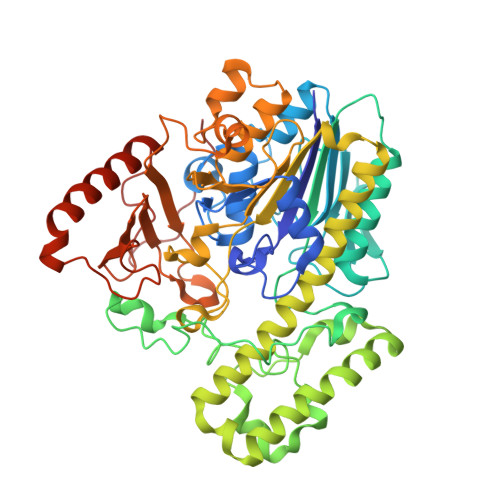Structural analysis of the sulfatase AmAS from Akkermansia muciniphila.
Li, C.C., Tang, X.Y., Zhu, Y.B., Song, Y.J., Zhao, N.L., Huang, Q., Mou, X.Y., Luo, G.H., Liu, T.G., Tong, A.P., Tang, H., Bao, R.(2021) Acta Crystallogr D Struct Biol 77: 1614-1623
- PubMed: 34866616
- DOI: https://doi.org/10.1107/S2059798321010317
- Primary Citation of Related Structures:
7EBP, 7EBQ - PubMed Abstract:
Akkermansia muciniphila, an anaerobic Gram-negative bacterium, is a major intestinal commensal bacterium that can modulate the host immune response. It colonizes the mucosal layer and produces nutrients for the gut mucosa and other commensal bacteria. It is believed that mucin desulfation is the rate-limiting step in the mucin-degradation process, and bacterial sulfatases that carry out mucin desulfation have been well studied. However, little is known about the structural characteristics of A. muciniphila sulfatases. Here, the crystal structure of the premature form of the A. muciniphila sulfatase AmAS was determined. Structural analysis combined with docking experiments defined the critical active-site residues that are responsible for catalysis. The loop regions I-V were proposed to be essential for substrate binding. Structure-based sequence alignment and structural superposition allow further elucidation of how different subclasses of formylglycine-dependent sulfatases (FGly sulfatases) adopt the same catalytic mechanism but exhibit diverse substrate specificities. These results advance the understanding of the substrate-recognition mechanisms of A. muciniphila FGly-type sulfatases. Structural variations around the active sites account for the different substrate-binding properties. These results will enhance the understanding of the roles of bacterial sulfatases in the metabolism of glycans and host-microbe interactions in the human gut environment.
Organizational Affiliation:
Center of Infectious Diseases, State Key Laboratory of Biotherapy, West China Hospital, Sichuan University and Collaborative Innovation Center, Chengdu 610041, People's Republic of China.
















